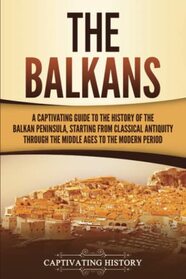The author of this book has an engaging writing style that propels the story along at a fast clip. Having read several tomes on the Crusades, it was interesting to read about these battles from the Balkan/Ottoman side (what was going on in the Balkans that alarmed people enough to call for help from the Western Christians).Â
After the Crusades, the Ottoman Empire eyed Constantinople. Finally, in 1453, the Ottomans seized Constantinople and toppled the Byzantine Empire. At that point, the Balkans were ripe for the plucking. There is an interesting description of the Janissaries, the elite fighting force of the Turks. They were the children of subjected people trained as fierce Turkish warriors.
Religion was complex in the Balkans. For example, one of the local traditions of Hungary was the belief in vampires. The author cleverly weaves the story of Vlad II and Vlad III Dracula (Vlad the Impaler) into this story of the Balkans. It certainly keeps the discussion lively. The Blood Countess, Elizabeth Bathory, is also mentioned. This is what happens when folks don't have television; they think of brutal ways to kill their enemies. Not to be outdone, the Ottoman leader, Hurshid Pasha, had a stone tower erected with fourteen rows of defeated Serbian skulls. He intended to scare the Serbs - but it didn't work.
The Ottoman's attempts to take Vienna are interesting because the reader sees it from the Ottoman perspective (instead of the usual Western Europe viewpoint). In fact, that is why I found this book to be so interesting. The stories come through from the opposite angle. Essentially, this book shows the power and gradual decline of the Ottoman Empire. The 'cage policy' of the Turkish leaders certainly explains the weakening of their leaders (Potential leaders hid away from the world; their first activities were as the leader of the country. They had little comprehension of how to rule).
My favorite quote in this book was by Tito (ruler of Yougoslavia): "I am the leader of one country which has two alphabets, three languages, four religions, five nationalities, six republics, surrounded by seven neighbors, a country in which live eight ethnic minorities." Certainly, that quote encompasses the challenges the Balkan states have grappled with for hundreds of years.
After the Crusades, the Ottoman Empire eyed Constantinople. Finally, in 1453, the Ottomans seized Constantinople and toppled the Byzantine Empire. At that point, the Balkans were ripe for the plucking. There is an interesting description of the Janissaries, the elite fighting force of the Turks. They were the children of subjected people trained as fierce Turkish warriors.
Religion was complex in the Balkans. For example, one of the local traditions of Hungary was the belief in vampires. The author cleverly weaves the story of Vlad II and Vlad III Dracula (Vlad the Impaler) into this story of the Balkans. It certainly keeps the discussion lively. The Blood Countess, Elizabeth Bathory, is also mentioned. This is what happens when folks don't have television; they think of brutal ways to kill their enemies. Not to be outdone, the Ottoman leader, Hurshid Pasha, had a stone tower erected with fourteen rows of defeated Serbian skulls. He intended to scare the Serbs - but it didn't work.
The Ottoman's attempts to take Vienna are interesting because the reader sees it from the Ottoman perspective (instead of the usual Western Europe viewpoint). In fact, that is why I found this book to be so interesting. The stories come through from the opposite angle. Essentially, this book shows the power and gradual decline of the Ottoman Empire. The 'cage policy' of the Turkish leaders certainly explains the weakening of their leaders (Potential leaders hid away from the world; their first activities were as the leader of the country. They had little comprehension of how to rule).
My favorite quote in this book was by Tito (ruler of Yougoslavia): "I am the leader of one country which has two alphabets, three languages, four religions, five nationalities, six republics, surrounded by seven neighbors, a country in which live eight ethnic minorities." Certainly, that quote encompasses the challenges the Balkan states have grappled with for hundreds of years.




